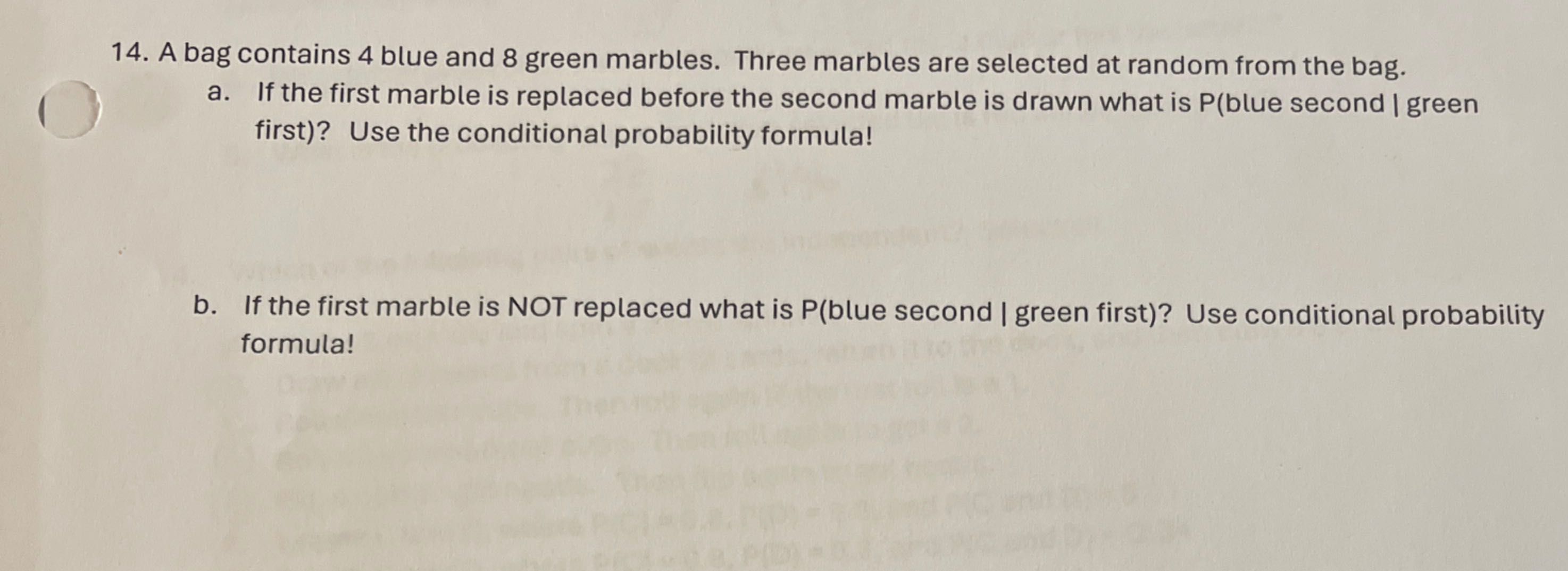AI tutor
Welcome to Bytelearn!
Let’s check out your problem:

A bag contains blue and green marbles. Three marbles are selected at random from the bag.a. If the first marble is replaced before the second marble is drawn what is (blue second I green first)? Use the conditional probability formula!b. If the first marble is NOT replaced what is P(blue second / green first)? Use conditional probability formula!
Full solution
Q. A bag contains blue and green marbles. Three marbles are selected at random from the bag.a. If the first marble is replaced before the second marble is drawn what is (blue second I green first)? Use the conditional probability formula!b. If the first marble is NOT replaced what is P(blue second / green first)? Use conditional probability formula!
- Calculate Probability with Replacement: a. Calculate the probability of drawing a blue marble second given that a green marble was drawn first with replacement.Since the first marble is replaced, the probability of drawing a blue marble remains the same for the second draw.
- Calculate Probability without Replacement: The total number of marbles is blue + green = marbles.The probability of drawing a blue marble is the number of blue marbles divided by the total number of marbles, which is or .
- Calculate Probability without Replacement: The total number of marbles is blue + green = marbles. The probability of drawing a blue marble is the number of blue marbles divided by the total number of marbles, which is or .Using the conditional probability formula , we need to find . Since the first marble is replaced, the events are independent, and . However, since we are given that a green marble is drawn first, is certain (), and thus .
- Calculate Probability without Replacement: The total number of marbles is blue + green = marbles. The probability of drawing a blue marble is the number of blue marbles divided by the total number of marbles, which is or . Using the conditional probability formula , we need to find . Since the first marble is replaced, the events are independent, and . However, since we are given that a green marble is drawn first, is certain (), and thus . Therefore, with replacement is simply the probability of drawing a blue marble, which is or approximately .
- Calculate Probability without Replacement: The total number of marbles is blue + green = marbles.The probability of drawing a blue marble is the number of blue marbles divided by the total number of marbles, which is or .Using the conditional probability formula , we need to find .Since the first marble is replaced, the events are independent, and .However, since we are given that a green marble is drawn first, is certain (), and thus .Therefore, with replacement is simply the probability of drawing a blue marble, which is or approximately .b. Calculate the probability of drawing a blue marble second given that a green marble was drawn first without replacement.Since the first marble is not replaced, the total number of marbles decreases by one, and the number of green marbles decreases by one.
- Calculate Probability without Replacement: The total number of marbles is blue + green = marbles.The probability of drawing a blue marble is the number of blue marbles divided by the total number of marbles, which is or .Using the conditional probability formula , we need to find .Since the first marble is replaced, the events are independent, and .However, since we are given that a green marble is drawn first, is certain (), and thus .Therefore, with replacement is simply the probability of drawing a blue marble, which is or approximately .b. Calculate the probability of drawing a blue marble second given that a green marble was drawn first without replacement.Since the first marble is not replaced, the total number of marbles decreases by one, and the number of green marbles decreases by one.Now we have blue marbles and green marbles left, making a total of marbles.The probability of drawing a blue marble on the second draw without replacement is now .
- Calculate Probability without Replacement: The total number of marbles is blue + green = marbles.The probability of drawing a blue marble is the number of blue marbles divided by the total number of marbles, which is or .Using the conditional probability formula , we need to find .Since the first marble is replaced, the events are independent, and .However, since we are given that a green marble is drawn first, is certain (), and thus .Therefore, with replacement is simply the probability of drawing a blue marble, which is or approximately .b. Calculate the probability of drawing a blue marble second given that a green marble was drawn first without replacement.Since the first marble is not replaced, the total number of marbles decreases by one, and the number of green marbles decreases by one.Now we have blue marbles and green marbles left, making a total of marbles.The probability of drawing a blue marble on the second draw without replacement is now .Therefore, without replacement is , which is approximately .
More problems from Find probabilities using the normal distribution I
QuestionGet tutor help
QuestionGet tutor help
QuestionGet tutor help
QuestionGet tutor help
QuestionGet tutor help
QuestionGet tutor help
QuestionGet tutor help
QuestionGet tutor help
QuestionGet tutor help
QuestionGet tutor help
